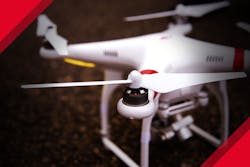Drones can change the construction landscape
For technology used on the construction sites of the future, the sky is the limit.
Literally.
Unmanned aerial vehicles (UAVs)—also commonly referred to as “drones”—are having a major impact on all sorts of industries around the world. Numerous commercial enterprises, from delivery services to news organizations, are embracing the flexible, formidable options that UAVs provide.
These UAVs are flying robots equipped with lightweight, maneuverable rotors and high-powered cameras capable of shooting dozens of minutes of high-definition video. Some UAVs can fly for nearly an hour on one charge, and they can be controlled by a remote control or smart phone.
For construction professionals, the integration of UAV technology presents a horde of possibilities. Aerial vehicles have the ability to:
- Reach places and see things that are outside the reach of ordinary workers
- Enhance surveying and modeling
- Monitor job sites for safety and security
- Inspect work in progress
- And/or capture HD video to give clients an aerial view of how their building is progressing
Some scientists have even programmed drones to build small structures independent of human guidance or instruction. As drone technology is tested and refined, even more possibilities will come into play. Drones have the potential to enhance and streamline the construction process, but their widespread use is currently stunted by the Federal Aviation Agency. The FAA prohibits the use of all unmanned aircraft for commercial use without the agency’s express approval. Fortunately, the FAA plans to allow the use of commercial UAVs once the appropriate regulations have been drafted.
Continue reading on the Star Buildings blog

